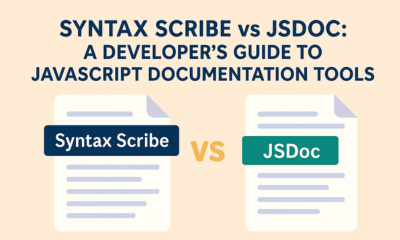
Syntax Scribe vs JSDoc: A Developer's Guide to JavaScript Documentation Tools
JavaScript documentation has evolved significantly over the years, with various tools emerging to help developers create and maintain comprehensive code documentation. Two notable approaches in this space are Syntax Scribe and JSDoc, each offering unique advantages for different development workflows. This comparison will help you understand which tool might be the best fit for your project.
What is JSDoc?
JSDoc is a well-established documentation generator for JavaScript that has been the industry standard for over a decade. It uses specially formatted comments in your source code to generate HTML documentation automatically. JSDoc follows a tag-based syntax that allows developers to describe functions, classes, modules, and other code elements with detailed metadata.
Key Features of JSDoc
Mature Ecosystem: JSDoc has been around since 2011 and has a vast ecosystem of plugins, themes, and integrations. It's supported by virtually every major IDE and text editor.
Standardized Syntax: The JSDoc comment format has become a de facto standard in the JavaScript community, making it familiar to most developers.
Type Annotations: JSDoc provides robust type annotation capabilities that work seamlessly with TypeScript and modern JavaScript tooling.
Flexible Output: Generate documentation in multiple formats including HTML, JSON, and custom templates.
What is Syntax Scribe?
Syntax Scribe is a more recent addition to the documentation landscape, designed to modernize the documentation generation process with a focus on simplicity and developer experience. It aims to reduce the overhead of maintaining documentation while providing more intelligent analysis of your codebase.
Key Features of Syntax Scribe
Automated Analysis: Syntax Scribe can infer documentation from your code structure, reducing the need for extensive manual annotation.
Modern Workflow Integration: Built with modern development practices in mind, including seamless integration with CI/CD pipelines and version control systems.
Interactive Documentation: Generates more interactive and searchable documentation compared to traditional static HTML outputs.
Minimal Configuration: Designed to work out-of-the-box with minimal setup and configuration.
Syntax and Usage Comparison
JSDoc Syntax Example
/**
* Calculates the area of a rectangle
* @param {number} width - The width of the rectangle
* @param {number} height - The height of the rectangle
* @returns {number} The area of the rectangle
* @example
* // Calculate area of a 5x3 rectangle
* const area = calculateArea(5, 3);
* console.log(area); // 15
*/
function calculateArea(width, height) {
return width * height;
}
Syntax Scribe Approach
// Syntax Scribe can often infer this automatically
function calculateArea(width, height) {
// Smart analysis recognizes mathematical operations
return width * height;
}
// Optional minimal annotation for complex cases
/** @scribe Enhanced description for complex logic */
function complexCalculation(data) {
// Implementation
}
Performance and Build Integration
JSDoc Performance
JSDoc processes documentation during build time, which can add significant overhead to larger codebases. The generation time scales with the number of documented functions and the complexity of your documentation templates.
Syntax Scribe Performance
Syntax Scribe is optimized for modern build tools and typically offers faster generation times. Its intelligent analysis can sometimes reduce the overall time spent on documentation maintenance.
Learning Curve and Adoption
JSDoc Learning Curve
JSDoc has a steeper learning curve due to its extensive tag system and configuration options. However, this complexity provides fine-grained control over documentation output. Most developers are already familiar with JSDoc syntax, making team adoption smoother.
Syntax Scribe Learning Curve
Syntax Scribe prioritizes ease of use with a gentler learning curve. New team members can often start contributing to documentation with minimal training. However, being newer, it may require additional onboarding for teams unfamiliar with the tool.
Integration and Ecosystem
JSDoc Integration
JSDoc integrates with virtually every JavaScript development tool:
- Native support in VS Code, WebStorm, and other major IDEs
- Extensive plugin ecosystem
- Integration with testing frameworks
- Support for custom themes and templates
- Works seamlessly with TypeScript
Syntax Scribe Integration
Syntax Scribe focuses on modern toolchain integration:
- Optimized for popular bundlers and build tools
- Strong CI/CD pipeline integration
- Modern web-based documentation interfaces
- Growing but still limited plugin ecosystem
Use Case Recommendations
Choose JSDoc When:
- Working with large, established codebases that already use JSDoc
- Your team values the extensive customization options and mature ecosystem
- You need comprehensive type annotations and complex documentation structures
- Integration with legacy tools and systems is important
- You're working on open-source projects where JSDoc is expected
Choose Syntax Scribe When:
- Starting new projects where you want minimal documentation overhead
- Your team prefers modern, streamlined tooling
- You want to minimize time spent on documentation maintenance
- Interactive and searchable documentation is a priority
- You're working in a fast-paced development environment
Migration Considerations
If you're considering migrating from JSDoc to Syntax Scribe or vice versa, consider these factors:
From JSDoc to Syntax Scribe: You may need to refactor existing documentation comments, but Syntax Scribe often provides migration tools to ease this process.
From Syntax Scribe to JSDoc: The migration typically involves adding more detailed annotations, but you gain access to the broader JSDoc ecosystem.
Conclusion
Both Syntax Scribe and JSDoc serve the essential purpose of JavaScript documentation, but they cater to different development philosophies. JSDoc remains the battle-tested choice for projects requiring comprehensive documentation control and broad ecosystem compatibility. Syntax Scribe represents the modern approach, prioritizing developer experience and automation over extensive customization.
Your choice should depend on your project's specific needs, team preferences, and long-term maintenance considerations. Consider factors like team size, project complexity, existing toolchain, and documentation requirements when making your decision.
Regardless of which tool you choose, the most important factor is consistency in documentation practices across your development team. Both tools can produce excellent documentation when used consistently and thoughtfully.